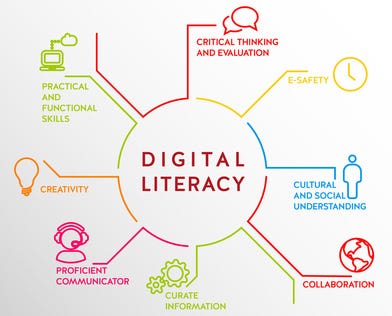
According to the Ministry of Education and Child Care, digital literacy is “the interest, attitude and ability of individuals to appropriately use digital technology and communication tools to access, manage, integrate, analyze and evaluate information, construct new knowledge, create and communicate with others” (Gov.bc.ca, 2023).
The Digital Literacy Framework consists of six characteristics which are:
- Research and Information Literacy
- Critical Thinking, Problem Solving, and Decision Making
- Creativity and Innovation
- Digital Citizenship
- Communication and Collaboration
- Technology Operations and Concepts
I believe that digital literacy is a very important skill to have, especially as we continue to integrate more and more technology into our daily lives. Teachers need to be digitally literate because by doing so we can take advantage of the many possible benefits that technology provides. Students who engage with digital literacy will be able to “apply digital tools to gather, evaluate, and use information. Students use critical thinking skills to plan and conduct research, manage projects, solve problems, and make informed decisions using appropriate tools and resources” (Gov.bc.ca,2023). Teachers can incorporate the teaching of digital literacy in many ways. A simple example of this would be to get your students to find online resources for whatever project they are currently working on. Simply going through the process of finding digital content could help students become more comfortable with the digital world.
Unicef states in their article titled Digital literacy for children- 10 things to know, that “digital literacy is increasingly recognized as a central element of the skills a child requires for school, work, and life. But what exactly does it mean for children to be digitally literate?” (Unicef.org, 2021) To answer this question, Unicef provides 10 important things to know. They are:
- Digital Literacy goes beyond technical know-how: It refers to the knowledge, skills and attitudes that allow children to be both safe and empowered in an increasingly digital world
- Children need to be digitally literate when they are not online: future job opportunities may depend on how well children understand the digital world
- Digital Literacy is a growing part of any approach to skills development
- Tools to develop and assess digital literacy are proliferating: International digital agencies and companies have developed digital competence frameworks.
- Yet most existing tools place little emphasis on children: Digital literacy of children needs to be emphasized.
- Few programmes operate at a scale or have been evaluated for impact.
- UNICEF programs would benefit from greater coordination.
- Implementing digital literacy is not easy: Although this is the case, we as future educators need to take up this challenge.
- Some existing digital literacy frameworks or tools suits UNICEF well.
- Digital literacy programmes should be context-driven: Beyond choosing a framework, an integrated approach to digital literacy involves undertaking a preliminary diagnostic review of the local context, developing operationalization guidelines and conducting impact assessments (Unicef.org, 2021).